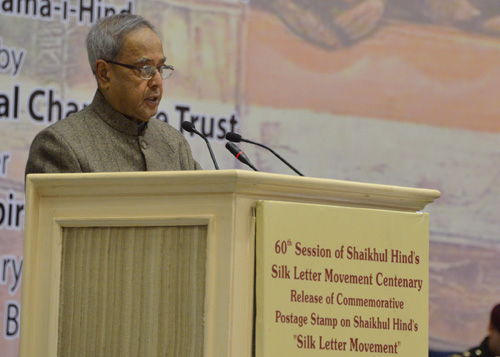Speech By The President Of India, Shri Pranab Mukherjee On The Occasion Of The Release Of Commemorative Postage Stamp On 'silk Letter Movement'
: 11.01.2013
 (43.22 KB)
(43.22 KB) It is indeed a happy occasion for me to be present here for the release of a stamp dedicated on ‘Silk Letter Movement’. As we all know, 15th August, 1947 was the culmination of almost two hundred years of resistance, intense political activity, including fasts, marches, protests, agitations and various types of movements. As we look back on the epic saga of this struggle, we are struck by the long drawn out and valiant fight put up by people from almost all walks of life without any thought towards their personal comfort and security. It was a widespread movement of multifaceted dimensions. In this movement people of various persuasions, following different ideologies, presented a multipronged resistance to foreign rule. This unique struggle was marked by a variety of approaches adopted by the people to rid the nation of the foreign domination. People who participated in the struggle belonged to various schools of thought and varied outlooks. Despite differences in their approaches and the methods of resistance to the foreign rule, they were all united in their desire to secure liberation for their motherland from yoke of colonial rule.
It is indeed a happy occasion for me to be present here for the release of a stamp dedicated on ‘Silk Letter Movement’. As we all know, 15th August, 1947 was the culmination of almost two hundred years of resistance, intense political activity, including fasts, marches, protests, agitations and various types of movements. As we look back on the epic saga of this struggle, we are struck by the long drawn out and valiant fight put up by people from almost all walks of life without any thought towards their personal comfort and security. It was a widespread movement of multifaceted dimensions. In this movement people of various persuasions, following different ideologies, presented a multipronged resistance to foreign rule. This unique struggle was marked by a variety of approaches adopted by the people to rid the nation of the foreign domination. People who participated in the struggle belonged to various schools of thought and varied outlooks. Despite differences in their approaches and the methods of resistance to the foreign rule, they were all united in their desire to secure liberation for their motherland from yoke of colonial rule.
The Silk Letter Movement was one such effort from a group of revolutionaries. This movement was a plan to mobilize the support of the governments of Afghanistan and Turkey in organizing a revolt within India to overthrow the British rule. Obaidullah Sindhi and Maulana Mahmood Hasan were two important leaders of this movement. In August 1916, some letters written on silk fell into British hands. It is believed that the Silk Letters confiscated by British Government contained details of the Provisional Government of Azad Hind and its plans and a comprehensive scheme of forming an army and getting the support of the Turkish Government.
The sacrifices of individuals and groups, such as those associated with the Silk Letter Movement, constitute a glorious chapter of India’s history of Freedom struggle and need to be acknowledged and appreciated. The stories of struggle need to be told and retold to a young generation born in a free India and enjoying the fruits of liberty.
I am happy that the Department of Posts has done its bit in this regard. Over the years, it has issued postage stamps to acknowledge the contribution of various groups and movements which in their own ways contributed to the overall effort to liberate India. The regular India Postage Stamps were introduced in October 1854 during the tenure of Governor General Lord Dalhousie. These were red lithographed stamps of one anna and blue lithographed stamps of half anna, bearing the portrait of Queen Victoria. This symbolism of British Monarchy came to an end with India gaining independence on 15th August, 1947. It was a proud moment when the greeting "Jai Hind” figured on the first three stamps issued by free India.
I am told that since then the Department has issued more than three thousand stamps, many of them on great personalities and events which had contributed to the freedom struggle.
I compliment Shri Kapil Sibal for his endeavour to dedicate stamp on the ‘Silk Letter Movement’, as it truly reflects the multi-cultural and multi-faceted dimension of the freedom struggle. I join you all in paying tribute the efforts and contributions of this great movement.








